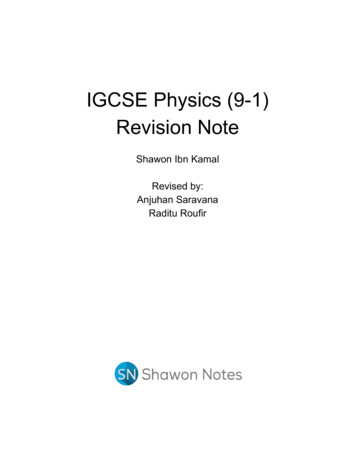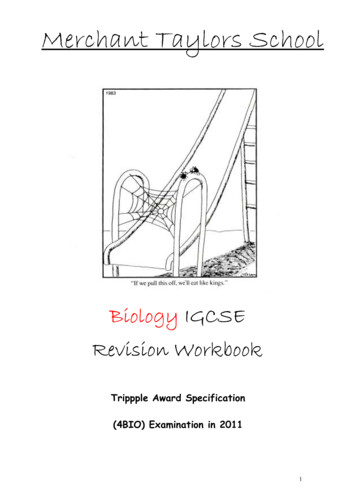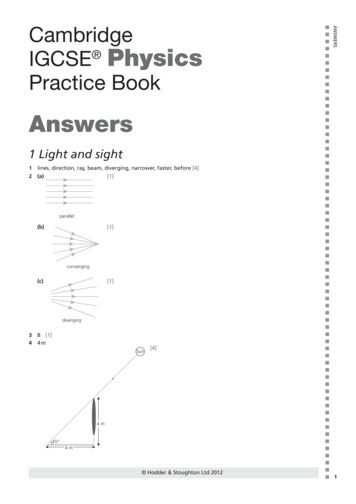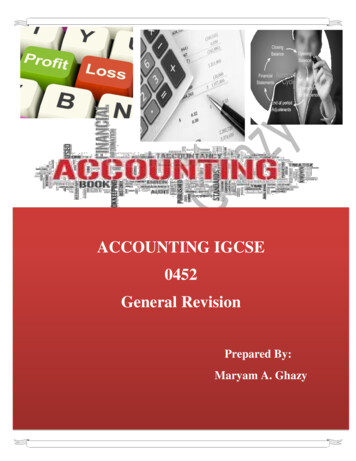
Transcription
IGCSE Physics (9-1)Revision NoteShawon Ibn KamalRevised by:Anjuhan SaravanaRaditu Roufir
Page intentionally kept blank.
Tables of ContentSection 1: Forces and motion5a) Units5b) Movement and Position5c) Forces, movement, shape and momentumSection 2: Electricity2257a) Units57b) Mains electricity57Section 3: Waves80a) Units80b) Properties of waves80c) The electromagnetic spectrum86d) Light and sound89Section 4: Energy resources and energy transfer109a) Units109b) Energy transfer109c) Work and power115d) Energy resources and electricity generation117Section 5: Solids, liquids and gases120a) Units120b) Density and pressure120c) Change of state123d) Ideal gas molecules125Section 6: Magnetism and electromagnetism129a) Units129b) Magnetism129c) Electromagnetism132Section 7: Radioactivity and particles141a) Units141b) Radioactivity141c) Fission and Fusion152Section 8: Astrophysics153(a) Units153(b) Motion in the universe153
(c) Stellar evolution153(d) Cosmology153Appendix 1: Electrical circuit symbols155Appendix 2: Physical units156Appendix 3: Prefixes157Appendix 4: Formulae and Relationships158Appendix 5: Glossary (131)159
Section 1: Forces and motiona) Units1.1 use the following units: kilogram (kg), metre (m), metre/second (m/s),metre/second2 (m/s2), newton (N), second (s), newton per kilogram (N/kg), kilogrammetre/second (kg m/s). Unit of mass Kilogram (kg) Unit of distance Metre (m) Unit of speed or velocity Metre per second (m/s) Unit of acceleration metre per second 2 (m/s 2 ) Unit of Force Newton(N) Unit of Time Second(s) Unit of gravitational acceleration Newton per kilogram(N/kg) Unit of Momentum kilogram metre per second (kg m/s)b) Movement and Position1.2 plot and interpret distance-time graphsDistance The change of position of an object is called distance. The diagram showsan example:Figure 1 shows an object changes its position from A to B. So the distance travelled bythe object is AB.Displacement The change of position of an object in a particular direction is calleddisplacement.
Figure 2 shows another object changes its position from C to D through curved path butthe displacement will be straight distance from C to D.Distance-time graphA distance-time graph represents the speed or velocity of any object. In this graph theobject is moving at 1 m per second. It is in a constant speed. In a distance-time graph,distance should go to the Y-axis while time should go over the X-axis.Speed gradient distance/time 3m/3s 1m/sFew points that should be noted:1. In a displacement – time graph or distance- time graph, the average velocity isfound by the ratio swhere s change in displacement/distance and t t time interval2. A positive gradient of the displacement-time graph indicates that the car ismoving in the same direction as the displacement.
3. A negative gradient of the displacement-time graph indicates that the car ismoving in the opposite direction to the displacement.4. A zero gradient of the displacement-time curve shows that the car is stationary.
Some explanation of motion from graph:Zero displacementConstant displacementNot movingAccelerationDeceleration
1.3 know and use the relationship between average speed, distance moved andtime:average speed distance moved /time takenSpeed: Speed is defined as the rate of change of distance. In other words, speed is thedistance moved per unit time. It tells us how fast or slow an object is moving.Most objects or bodies do not move at constant speed. For example, the MRT trainstarts from rest at a station, moves faster and faster until it reaches a constant speedand then slows down to a stop at the next station. It is therefore more useful to defineaverage speed rather than the actual speed.Average speed: Average speed is the total distance moved divided by total time taken.If you see the graph in 1.2 it had an average speed of 1 m/s. This is the relationbetween speed and distance,time. Distance and time has no relation individually. Theyare both different types of values.Instantaneous speed: The speed of an object at a particular moment is calledinstantaneous speed. It is measured by taking ratio of distance travelled by shortestpossible time.Difference between speed and velocity:Speedi. The rate of distance travelled is speed.ii. Speed can be in any direction.iii. Speed is a scalar quantity.Velocityi. The rate of displacement travelled isvelocity.ii. Velocity is speed in particular direction.iii. Velocity is a vector quantity.1.4 describe experiments to investigate the motion of everyday objects such astoy cars or tennis ballsExperiment: Measuring speed using click and stopwatchSuppose you want to find the speed of cars driving down your road. You may have seenthe police using speed guns to check that drivers are keeping to the speed limit. Speedguns use microprocessors to produce an instant reading of the speed of a movingvehicle, but you can conduct a very simple experiment to measure car speed.
Measure the distance between two points along a straight section of road with a tapemeasure or “click” wheel. Use a stopwatch to measure the time taken for a car to travelthe measured distance.Use the speed, distance and time equation to work out the speed of the car.Experiment : Measuring speed using light gate method1.2.3.4.5.6.Attach a cart of measured length centrally to the top of the toy car.Air track ensures a frictionless way for the toy car.A gentle push can move the toy car at a steady speed.Arrange for the card to block a light gates beam as it passes through it.Electronic timer measures how long the card takes to pass through the beam.Now calculate the toy car's average velocity as it passes the light gate by:v length of the cardinteruption timeExperiment : Measuring speed using ticker-time method
Experiment : Video (sequence) method – Measuring the velocity of a tennis ball.A tennis ball is let to move on a track at a steady speed. During the ball moves, videothe ball moving along in front of calibrated scale (a scale where there is marking inlength) attached to the slope.Play the video back to get the snap shots taken at a time. Measure how far the balladvances between snaps from the scale. The video camera can take 25 snaps eachsecond. So the time between each snap is 0.04 second.Now calculate the balls average velocity between snaps using the followingequation:Velocity distance moved between snaps 0.04Experiment : To find out Average Speed of Toy car or trolleyApparatus: Toy car or tennis ball, meter rule, slotted masses, stopwatch, thread.Procedure:1. Put toy car on bench and attach pulley to the corner of the bench as shown in figure.2. Attach one end of the thread with toy car and other end with slotted masses whilehanging them over pulley.3. Keep toy car & pulley one meter apart with meter rule.
4. Hold the toy with hand so that it remains there immovable.5. Time stop watch when you let toy to move a meter distance.6. Repeat this & record reading for different distances in the following chart.7. Draw graph to find out average speed, which can be found by finding the gradient ofthe graph.Precautions:1. Do not hang heavier masses as this may break the thread.2. Wear shoes as to avoid injury to foot in case of broken thread and fall of mass.3. Put something soft under the hanging mass, like tray filled with sand.Sources of error:1. Reaction time2. Ruler may not be straight3. Parallax error4. Friction in the bench.Ways to improve:1. Bench should be very polished friction.2. Tyres of the toy should not be very rough.3. Use light-gates instead of the stopwatch and connect light-gates to datalogger andthen to computer, to get more accurate results.Experiment : Measuring acceleration using light gate method
A card is mounted on the top of a trolley. The length of the card is measured.One light is set at the top of the track and the second one is at the end of thetrack.The trolley is given a gentle push to move through the track.When the trolley passes through the first light gate the electronic timer measuresthe t 1 tocross the length of the card. So the velocity at the position of first light gate is measured by velocity.o V1 length of the first card t 1During passing the second light gate, if the time measured by electronic timer ist2 then thevelocity can be measured by:o V2 length of the second card t 2The time t 3 is measured for the trolley to travel from first light gate to the secondlight gate by using a stopwatch.Now acceleration is velocity difference t 3 {( length of the first card t1 )-( length of the second card t 2)} t 3 Experiment :Measuring acceleration using Video (sequence) methodExperiment : Measuring acceleration using Modern Version of Galileo’s Experiment:Apparatus Light gateInterrupterAir pumperAir trackData logger or electronic timerDiagram –
Working Procedure - We can measure the acceleration by conducting an experimentusing an air-track which can be referred as the modern-version of Galileo experiment.From the diagram show the investigation where we can see that the air-track reducesfriction because the glider rides on a cushion of air that is pumped continuously throughholes along the air track. As the glider accelerates down the sloping track the white cardmounted on it breaks a light beam, and the time the glider takes to pass is measuredelectronically. If the length of the card is measured, and this is entered into thespreadsheet, the velocity of the glider can be calculated by the spreadsheet programmeusing v d/t.Observation - Here from the above procedure it is observed that the distance travelledin equal intervals is increased and that the rate of increase of speed is steady or uniformi.e. it is uniform acceleration.Table and Graph
ConclusionThe gradient of a velocity-time graph gives the accelerationExperiment :Measuring acceleration using double light gate.1. A card is mounted on the top of a trolley.2. The length of the card is measured.3. One light gate is at the top of the track and another light gate is at the end of thetrack.4. The trolley is given a gentle push to move through the track.5. When the trolley passes through the first light gate, the electronic timer measure thetime (t 1 ) to cross the length of the cord.6. So the velocity at the position of first light gate is measured by:v elocity, v 1 length of the cordt2
7. The time, t 3 is measured for the trolley to travel from first light gate to 2 nd light gate byusing a stopwatch.8. Now, acceleration velocity dif f erencet3 length of card length of card t2t1t3Experiment : Measuring acceleration using ticker tape.Apparatus: Ticker timer and tape, a.c. power supply, trolley, runwayProcedure:1. Set up the apparatus as in the diagram.2. Connect the ticker timer to a suitable low-voltage power supply.3. Allow the trolley to roll down the runway.4. The trolley is accelerating as the distance between the spots is increasing.5. The time interval between two adjacent dots is 0.02 s, assuming the ticker timer marsfifty dots per second.6. Mark out five adjacent spaces near the beginning of the tape. Measure the length s1.7. The time t1 is 5 0.02 0.1 s.8. We can assume that the trolley was travelling at constant velocity for a small timeinterval.Thus initial velocity u distance/time s1/t19. Similarly mark out five adjacent spaces near the end of the tape and find the finalvelocity v.
10. Measure the distance s in metres from the centre point of u to the centre point of v.11. The acceleration is found using the formula: v2 u2 2as or a v2 – u2 / 2t12. By changing the tilt of the runway different values of acceleration are obtained.Repeat a number of times.13. Tabulate results as shown.1.5 know and use the relationship between acceleration, velocity and time:Acceleration is the rate at which objects change their velocity. The rate of decease ofvelocity is called deceleration. It is just a negative acceleration. It is defined as follows:Acceleration change in velocity/time takenor(final velocity-initial velocity) /time takenThis is written as an equation:a v utwhere a acceleration, v final velocity, u initial velocity and t time1.6 plot and interpret velocity-time graphs
Velocity-time graphs represent the acceleration of any object. Velocity(m/s) is in theY-axis while Time is the X-axis.Some common velocity-time graphs:
1.7 determine acceleration from the gradient of a velocity-time graphAcceleration gradienty y x2 x 121200 050 0 4 m/s 21.8 determine the distance travelled from the area between a velocity-time graphand the time axis.Distance can be determined by finding the area under a velocity-time graph as shownbelow:#
Distance travelled area under the graph ½ (a b)h ½ (100 40) x 150 ½ x 140 x 150 10500m#
i) Acceleration in first 60s y 2 y 1x2 x140 060 02m/s 23ii) Distance in 100s ½ x b x h l x b ½ x 60 x 40 40 x 60 1200 2400 3600 miii) Average Speed dt 2800/100 28 m/s
#Maximum speed 60 m/sAcceleration Part – 1 y 2 y 1x2 x160 20 3 m/sy 2 y 1x2 x140 060 40Part – 2 2 m/sy 2 y 1x2 x140 090 80Part – 3 4 m/s 2c) Forces, movement, shape and momentum1.9 describe the effects of forces between bodies such as changes in speed, shape ordirectionForce is that which can change the state of rest or uniform motion of an object. It issimply pushes and pulls of one thing on another.If a body is thrown up in the air, what is the effect of gravity on the body? At first gravityreduces the speed of upward movement of the body and at a certain height it stops. SoForce effects the speed.
Take a sponge and squeeze it will change its shape.Throw a ball at a person in one direction. That person will hit the ball again i.e. applyforce to the ball and it will change its direction.To sum up the examples, the effects that occur when a force is applied to an object are:1.2.3.4.The object may start to move or stop moving.The object may speed up or slow down.The object may change its shapeThe object may change its direction of movement.1.10 identify different types of force such as gravitational or electrostaticDifferent sorts of Force:1) Gravitational force or weight: The pull of earth due to gravity.2) Normal Reaction: Simple reaction that stops something when to apply force to it.E.g.: A book is kept on the table which has a normal reaction on it. Otherwise thebook would fall down.3) Air Resistance: The resistivity or drag in the air while an object moves is calledAir Resistance.E.g.: When a parachutist open the parachute the movement slowsdown for the opposite force acting in it.4) Upthrust: Upthrust force acts only on liquid or air. It pushes an object upwardsinspite of gravity. E.g.: A helium balloon moves upwards due to up thrust force.5) Magnetic: Magnetic force is the attraction force between the poles of magnets.N S6) Electrostatic: Electrostatic force is the attraction force between charges. 7) Tension: The pull at both ends of a stretched spring ,string, or rope.8) Frictional force: the force produced when two objects slide one over another iscalled frictional force.1.11 distinguish between vector and scalar quantitiesScalar quantities are physical quantities that have magnitude only.Vector quantities however are physical quantities that possess both magnitude as wellas VelocityAcceleration
calarNeeds only size to express themChanges by changing size.Product of two scalar is a scalar i.e scalarX scalar scalar.VectorNeeds both size and direction to expressthem.Changes by changing size or direction oreven both.Products of two vectors can be either bescalar or vector i.e.vector X vector scalar/vector.1.12 understand that force is a vector quantityForce is a vector quantity due to the following reasons It has magnitude i.e has the value of its size.It has direction.When applied force, an object moves with particular motion in a fixed direction.E.g: Gravitational force has one direction which is downwards. Upthrust has thedirection of upwards.1.13 find the resultant force of forces that act along a lineForces which act along a straight line can be added if the forces are in the samedirection or subtracted if the forces are in the opposite direction. The force that you getafter adding or subtracting is called the resultant force. The resultant force is a singleforce that has the same effect as all the other forces combined.Figure 1Figure 2
Figure 1 shows that two forces: 150N and 50N are acting on an object A in the samedirection and the object is moving.Figure 2 shows that a single from 200N is acting on the same object and the objectmoves at the same motion. So 200N is the resultant force of 150N and 50N.
Examples are i.Resultant force (500 - 200)N 300 N (towards right)ii.Resultant force 1000 – 1000 0 N (rest object)1.14 understand that friction is a force that opposes motionFriction is the force that causes moving objects to slow down and finally stop. Thekinetic energy of the moving object is converted to heat as work is done by the frictionforce. Friction occurs when solid objects rub against other solid object and also whenobjects move through fluids(liquids and gases).Types of frictions: Kinetic friction: The friction that occurs when the object is in motion is calledkinetic friction. E.g: Friction deduced in a moving car.Static friction: The friction produced when force is applied but the object doesn’tmove is called static friction. E.g: a block is pulled but it doesn’t move becausethe force is not enough to move it. The friction produced in the block in thissituation is the static friction.Rolling friction: When an object rolls around another object, a friction is produced.This is called rolling friction. E.g.: The car wheel moves around the axel androlling friction is produced.
Fluid friction: The friction produced when two liquid layer side by side moves atdifferent speed is called fluid friction.Solid-fluid friction: When a solid moves through a fluid, a friction is produced tothe motion. This is called solid-fluid friction.Causes of friction: Ridges and bumps between the surfaces.The attraction force between the molecules of containing surfaces.Ways to reduce friction: By making the surface smooth,By using lubricating oil such as mobile, grease etc.Advantages of friction: We can walk and run due to friction.We can fix a nail in the wall due to friction.We can hold a pen due to friction.Disadvantages of friction: Friction causes wear and tear in the surface.It reduces the efficiency of the machines.There is wastage of energy due to friction.
Experiment : To investigate frictionAs shown on the diagram above, a block is set on the surface of the track. A nylon lineis connected to it which passes over a pulley to a weight. There is friction between thesurface of the block and the surface of the track. When the pull of weight equals to thefriction then the block starts moving. So the amount of the weight that starts the block tomove is equal to the friction.We can increase the friction by putting some masses over the and we will see that themore is the mass the more is the friction. We can make the track surface rougher suchas byusing sand paper we will see the friction increases.1.15know and use the relationship between unbalanced force, mass andacceleration:Balanced force - When two or more forces acting on an object cancels each other andthere is no resultant force, then the forces are called balanced force.200N and 300N are acting towards left on the object A. 500N force is acting on ittowards right. The forces cancel each other. So there is no resultant force. So theseforces are called balanced forces.Unbalanced force - When two or more forces acting on an object do not cancel eachother fully and there is a resultant force, then the forces are called unbalanced force.
400N and 200N are acting on the object A towards right direction. 300N is actingtowards left direction. The forces do not cancel each other fully. There is resultant forceof 300N towards right. So their forces are unbalanced.Force mass x accelerationIn equation, F ma(where, m mass and a acceleration)FαaForce is directly proportional to acceleration. If force increases acceleration increases.Experiment : To investigate F α aWorking principle - The rate of change of momentum is directly proportional to theapplied force and takes place in the direction of force.Apparatus required TrolleyNylon linePulleyRampBench topMass hangerDiagram -
Working procedure - The force acting on the trolley is produced by the masses on theend of the nylon line. As the mass is increased, the trolley accelerates as well, so theforce is increased by the transferring one of the masses from the trolley to the masshanger.In the diagram-b, this increases the pulley force on the trolley, while keeping the totalmass of the system the same. The acceleration of the trolley can be measured by takinga series of pictures at equal intervals of time using a digital video camera.Observation - Here, using the digital video camera, as sequences of pictures are taken,the distance travelled from the start for each image is measured, since the timebetween each image is known, a graph of displacement against time can be drawn. Thegradient of the displacement-time graph gives the velocity at a particular instant, sousing the value data for a velocity-time graph can be obtained. The gradient of thevelocity-time graph produced is the acceleration of the trolley.Graph -
Conclusion - The force and acceleration is same and this produces a straight-line graphwhich determines that force is directly proportional to force. So doubling the force actingon an object doubles its acceleration.Experiment : To investigate a α 1/mThe same experiment as above, only the force is kept constant and the mass of thetrolley is varied.The graph shows the acceleration of the trolley plotted against 1/m. This is also astraight line passing through the origin, showing that acceleration is inverselyproportional to mass.aα 1/mThis means that for a given unbalanced force acting on a body, doubling the mass ofthe body will halve the acceleration.Combining Experiment 1 and 2, we get:
F m xaOne newton is the force needed to make a mass of one kilogram accelerate at onemetre per second squared.1.16 know and use the relationship between weight, mass and g:Weight is the pull of earth. To calculate it, use the formula:Weight mass x gravitational accelerationW mgGravitational field strength: The pull of planet on an object of 1 kilogram is calledgravitational field strength. It is also denoted by g, where in earth g 10 m/s 2 if there isno opposite force.
Experiment :To verify acceleration due to gravity using video cameraWe could measure the distance between two images of the tennis ball – say, thesecond and the third. This is the distance that the ball travelled during the secondinterval of one tenth of a second. The average velocity during this time is found bydiving the distance travelled, 14.7 cm, by the time taken, 0.1s. This gives an averagevelocity of 147 cm/s or 1.47 m/s over the interval. If we repeat the calculation for thenext tenth of a second, between 3 and 4m we find the average velocity has increased to2.45 m/s. We can then use the equation for acceleration.The result of this experiment gives us a value for acceleration caused by the force ofgravity.
Experiment: To measure acceleration due to gravity using electromagnetApparatus: Millisecond timer, metal ball, trapdoor and electromagnet.Procedure:1. Set up the apparatus as shown. The millisecond timer starts when the ball is releasedand stops when the ball hits the trapdoor.2. Measure the distance, s using a meter stick.3. Flick the switch to release the ball and record the time, t from the millisecond timer.4. Repeat for different values of s.5. Calculate the values of g using the equation s (g/2) t 2 . Obtain an average value forg.6. Draw a graph of s against t 2 and use the slope to find the value for g.Precautions/ Source of error:1. For each height s repeat three times and take the smallest time as the correct valuefor t.2. Place a piece of paper between the ball bearing and the electromagnet to ensure aquick release.3. Remember to convert from milliseconds to seconds.
1.17 describe the forces acting on falling objects and explain why falling objectsreach a terminal velocityTerminal velocity is the steady velocity of a falling object whose drag is balanced by theweight.How does a falling object reach terminal velocity?In a free falling object two types of force acts: Drag and Weight. The size of the dragforce acting on an object depends on its shape and its speed. If the drag force of anobject increases to a point which is equal to Weight, then the acceleration stops. It fallsin a constant velocity known as terminal velocity.
Reaching terminal velocity on a parachute:When a skydiver jumps from a plane at high altitude he will accelerate for a time andeventually reach terminal velocity. When she will open her parachute, this will cause asudden increase in the drag force. At that time drag force will be higher than the weightand he will decelerate for some time. Later those forces will become equal and reach anew terminal velocity.
1.18 describe experiments to investigate the forces acting on falling objects, suchas sycamore seeds or parachutesSycamore seeds:We can measure the weight of the sycamore seeds using an electric balance. Now thesycamore seed is released from a high point. We will use a digital video camera to takethe snaps of the moving seed. The video camera can take 25 snaps in one second. Wecan measure the acceleration of the ball at any point using the snaps of the movingseed. Now multiplying the mass of the seed by acceleration at any point we can find theunbalanced force acting on it. If we subtract the unbalanced weight from its weight, wewill get the air resistance acting on the seed.Parachutes:When a parachute is released only the weight acts on it. We can use a force meter todetermine the weight. When the parachute falls downward, air resistance acts on it inthe upward direction. So the downward unbalanced force decreases. The force meterattached to the parachute gives a lower reading. As the parachute goes down the speedincreases. The drag force also increases. The reading on the force meter decreases aswell. A moment comes when the drag force becomes equal to the weight. In thissituation the reading in the force meter becomes zero. If we want to find the airresistance at any momentum we will have to subtract the weight from the unbalancedforce. This is how we can investigate the forces acting on a falling object.1.19 describe the factors affecting vehicle stopping distance including speed,mass, road condition and reaction timeStopping distance: The stopping distance is the sum of Thinking distance and Brakingdistance.Thinking distance: The distance travelled after seeing an obstacle and till reaction.Braking distance – The distance travelled after the brakes are applied.The thinking distance depends on the following factors i.ii.iii.Whether the driver is tired or has taken alcohol or drugs.On the visibility power of the driver.On the speed of the car.The braking distance depends on the following factors -
i.ii.iii.iv.v.Speed of the car: The more the speed is, the more the braking distancewill be; S α V2 . Mass of the car : As acceleration is equal to F/m, for constant brakingforce, the moreis the mass, the less is the deceleration, the more isthe braking distance.Road condition: If the road is rough, the braking distance will be less.Tyre condition: If the tyre is new (rough), there will be less brakingdistance.Braking system: For loose braking system, the braking distance will bemore.1.20 know and use the relationship between momentum, mass and velocity:Momentum is a quantity possessed by masses in motion (product of mass and velocity).Momentum is measure of how difficult it is to stop something that is moving. Wecalculate the momentum of a moving object using the formula:Momentum,p(kg m/s) mass, m(in kg) x velocity, v (in m/s)P mxv1.21use the idea of momentum to explain safety featuresObjects in a car have mass, speed and direction. If the object, such as a person, is notsecured in the car they will continue moving in the same direction (forward) with thesame speed (the speed the car was going) when the car abruptly stops until a force actson them.Every object has momentum. Momentum is the product of a passenger's mass andvelocity (speed with a direction). In order to stop the passenger's momentum they haveto be acted on by a force. In some situations the passenger hits into the dashboard orwindshield which acts as a force stopping them but injuring them at the same time.
1 Crumple ZoneCars are now designed with various safety features that increase the time over whichthe car’s momentum changes in an accident. Crumple zones are one of the safetyfeatures now used in modern cars to protect the passengers in an accident. The car hasa rigid passenger cell with crumple zones in front and behind. During a collision, itincreases the time during which the car is decelerating. This also reduce the forceimpacting on the passenger increasing their chances of survival.2 Air BagsMany cars are now fitted with air bags to reduce the forces acting on passengers. Thepurpose of an airbag is to help the passenger in the car reduce their speed in collisionwithout getting injured. An airbag provides a force over time. This is known as impulse.
The more time the force has to act on the passenger to slow them down, the lessdamage caused to the
IGCSE Physics (9-1) Revision Note Shawon Ibn Kamal Revised by: Anjuhan Saravana Raditu Roufir . Page intentionally kept blank. Tables of Content Section 1: Forces and motion 5 a) Units 5 b) Movement and Position 5 c) Forces, movement, shape and momentum 22 Section 2: Electricity 57 a) Units 57 b) Mains electricity 57 Section 3: Waves 80 a .










